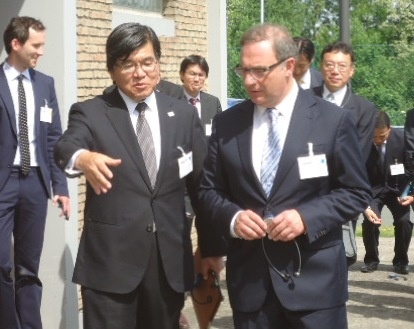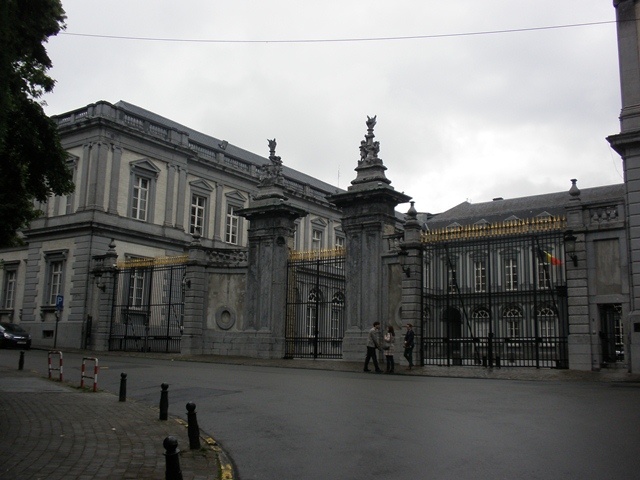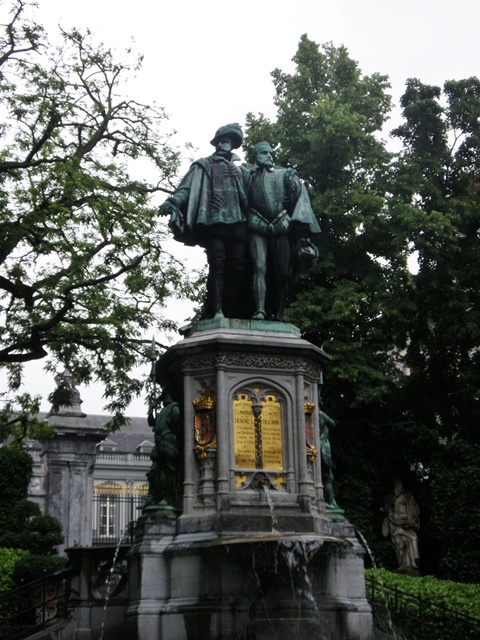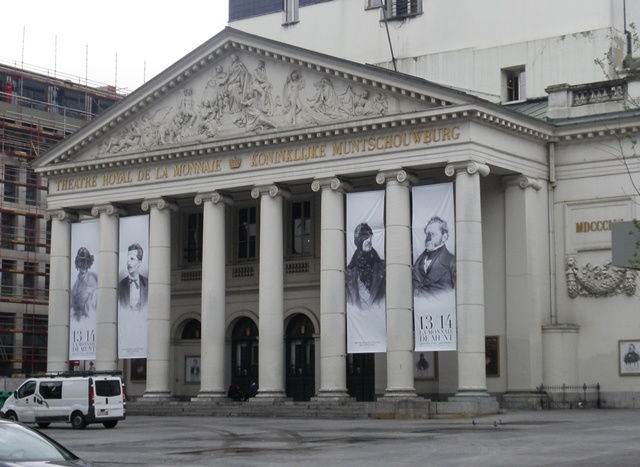Taxes in Belgium (No.21)
I vaguely thought that “Belgium is a country with high taxes”, but recently I was surprised to see a comparison table of personal income tax and corporate tax in EU countries released by the Statistical Office of the European Union. The Belgian VAT (consumption tax) is 21%, which is high even for Europe and bears no comparison with the 5% in Japan (8% as of next April and expected to be further raised to 10%). The corporate tax rate is 34% which is slightly lower than that of France (36.3%), but it is in Europe’s top class. By the way, the corporate tax rate of Germany is 29.8% and that of the UK is 23% and some countries have even a 10% range. Corporate tax in Japan will be lowered by a legal reform from 30% to 25.5 % (almost at the same level as in China and in South Korea), but even so, that comes down to the average European level. What is surprising is the personal income tax. In case of Belgium, the income tax rate is 42.3% on average and the highest tax rate is 53.7%. Even though income tax as well as corporate tax has dropped considerably compared to a certain period, I do have to say that it is still high in comparison with the highest tax rate of 40% in Japan. Moreover, there is a system of income deduction in Japan, which means that even in the case of an annual income of apporoximately140.000 euro (from which amount the highest rate is applied), the actual tax rate will be around 25%. It shows the high level of the Belgian income tax. However, a simple comparison is difficult because of the tax reduction system for income tax, just like the various tax breaks for corporate tax.
< A Reception Organized by His Majesty King Albert II at the Royal Laeken Castle >
Three days ago, a reception for the diplomatic corps, organized by His Majesty King Albert II, was held at the Royal Castle of Laeken in the north of Brussels. The New Year’s Reception was held at the Royal Palace in the centre of Brussels (see Ambassador’s Chat No.6), but the reception that is held every year in early summer takes place customarily at the Royal Castle of Laeken, the residence of the King. However, only new ambassadors who have taken up their post in Belgium less than 1 year ago were invited, so there were about 50 ambassadors present. Ambassadors and their spouses formed a line based on the order of arrival in Belgium. When the Master of Ceremonies called the country name, it is the tradition that you step forward in front of Their Majesties, express your gratitude for the invitation and greet His Royal Highness the Crown Prince and the Crown Princess. After having greeted all ambassadors, Their Majesties, together with Ambassadors, moved to the courtyard terrace for a ceremony that was similar to a small imperial garden party. My spouse and I were guided by the Chamberlain and had the opportunity to speak individually with Their Majesties the King and the Queen. I told them that the visit to Japan by Her Royal Highness Princess Astrid last April to boost the interest in Japan for the fight against malaria had been very successful and that while she was in Japan Her Royal Highness had meaningful meetings with the members of the Japanese Imperial Family including their Majesties the Emperor and the Empress to deepen friendship relations. I was all the more impressed that each ambassador invited to this reception was given the opportunity to socialize with Their Majesties the King and the Queen.
< Business Tour to La Louvière >
 On the same day, I visited La Louvière (60 km south of Brussels: 79.000 inhabitants) with 14 members from Japanese companies in Belgium. This event was proposed to me four months ago by Mr. Olivier Destrebecq, member of the House of Representatives and also échevin (deputy mayor) of La Louvière. On the day of the event we received a warm welcome from the early morning on. First, we greeted the mayor, Mr. Jacques Gobert at the city hall where staff members and Development Agency staff explained about the economic situation and the development program of La Louviere, which is the 5th largest city in Wallonia. Consecutively, we visited a Japanese company called JTEKT TORSEN EUROPE (affiliated with TOYOTA) in the neighbouring municipality. This company is manufacturing automobile driveline such as intelligent torque control coupling components since 1989 for export to Germany and other countries. The manufacturing process is mechanized and is operational everyday 24 hours in 3 shifts non-stop. Yet it is surprising that there are only 155 employees among which 3 Japanese. At the end of our tour, I was interviewed individually by 4 media companies such as a local TV station. On the Belgian side I felt a strong interest for new investments from Japan. The last visit was to a business park under development under the guidance of the Development Agency staff. A number of companies are already active in the vast grounds of the park, but because the vacant space is underdeveloped it is hard to picture the industrial site. However, the highway and canal are close, so the logistics seemed good. Mayor Gobert and Mr. Destrebecq accompanied us from the beginning to the end on this tour and all of us Japanese felt very obliged for the police motorcycle that escorted us the whole time. On the same day, I visited La Louvière (60 km south of Brussels: 79.000 inhabitants) with 14 members from Japanese companies in Belgium. This event was proposed to me four months ago by Mr. Olivier Destrebecq, member of the House of Representatives and also échevin (deputy mayor) of La Louvière. On the day of the event we received a warm welcome from the early morning on. First, we greeted the mayor, Mr. Jacques Gobert at the city hall where staff members and Development Agency staff explained about the economic situation and the development program of La Louviere, which is the 5th largest city in Wallonia. Consecutively, we visited a Japanese company called JTEKT TORSEN EUROPE (affiliated with TOYOTA) in the neighbouring municipality. This company is manufacturing automobile driveline such as intelligent torque control coupling components since 1989 for export to Germany and other countries. The manufacturing process is mechanized and is operational everyday 24 hours in 3 shifts non-stop. Yet it is surprising that there are only 155 employees among which 3 Japanese. At the end of our tour, I was interviewed individually by 4 media companies such as a local TV station. On the Belgian side I felt a strong interest for new investments from Japan. The last visit was to a business park under development under the guidance of the Development Agency staff. A number of companies are already active in the vast grounds of the park, but because the vacant space is underdeveloped it is hard to picture the industrial site. However, the highway and canal are close, so the logistics seemed good. Mayor Gobert and Mr. Destrebecq accompanied us from the beginning to the end on this tour and all of us Japanese felt very obliged for the police motorcycle that escorted us the whole time.
< GGA and Foreign Minister Didier Reynders >
  I mentioned already a few of times that there are 300 people with the title of “Ambassador” in Brussels and, among these, 14 ambassadors created the “Groupe Gastronomique des Ambassadeurs (GGA)”. Every month these ambassadors take turns organizing a luncheon. Members are French-speaking ambassadors stationed in Belgium with an interest in food culture and occasionally also executives from the Belgian Foreign Ministry attend. However, to celebrate the 20th anniversary of the start of the GGA, the Foreign Minister Mr. Didier Reynders himself held a banquet at the Egmont Palace. Mr. Reynders, being also a Vice Premier and a cabinet member as a representative of his political party, is a very busy politician covering not only diplomacy but also general state affairs. Getting acquainted with the Foreign Minister is indispensable as an ambassador, so this dinner was a valuable opportunity for me. By the way, the Egmont Palace was built by the Count of Egmont in the 16th century and became national property about 50 years ago after many twists and turns. Today the Palace serves as a reception hall for the Ministry of Foreign Affairs. As mentioned in Ambassador’s Chat No. 18, the Count of Egmont was a central figure in the struggle for independence from Spain in the second half of the 16th century and was executed at the Grand Place in Brussels. The Egmont Palace is situated near the Petit Sablon (not as far from the Grand Place) where there is a statue of the Count of Egmont. Beethoven composed the “Egmont Overture” in 1810, exactly at the time when Austria was trampled down by Napoléon’s army. The Count of Egmont is a symbol of resistance against foreign invading forces and it is an interesting fact that the palace built by the Count of Egmont is used as a reception hall for the Ministry of Foreign Affairs after more than 400 years. I mentioned already a few of times that there are 300 people with the title of “Ambassador” in Brussels and, among these, 14 ambassadors created the “Groupe Gastronomique des Ambassadeurs (GGA)”. Every month these ambassadors take turns organizing a luncheon. Members are French-speaking ambassadors stationed in Belgium with an interest in food culture and occasionally also executives from the Belgian Foreign Ministry attend. However, to celebrate the 20th anniversary of the start of the GGA, the Foreign Minister Mr. Didier Reynders himself held a banquet at the Egmont Palace. Mr. Reynders, being also a Vice Premier and a cabinet member as a representative of his political party, is a very busy politician covering not only diplomacy but also general state affairs. Getting acquainted with the Foreign Minister is indispensable as an ambassador, so this dinner was a valuable opportunity for me. By the way, the Egmont Palace was built by the Count of Egmont in the 16th century and became national property about 50 years ago after many twists and turns. Today the Palace serves as a reception hall for the Ministry of Foreign Affairs. As mentioned in Ambassador’s Chat No. 18, the Count of Egmont was a central figure in the struggle for independence from Spain in the second half of the 16th century and was executed at the Grand Place in Brussels. The Egmont Palace is situated near the Petit Sablon (not as far from the Grand Place) where there is a statue of the Count of Egmont. Beethoven composed the “Egmont Overture” in 1810, exactly at the time when Austria was trampled down by Napoléon’s army. The Count of Egmont is a symbol of resistance against foreign invading forces and it is an interesting fact that the palace built by the Count of Egmont is used as a reception hall for the Ministry of Foreign Affairs after more than 400 years.
< The Francqui Prize and President Hoover >
About 10 days ago, I attended the award ceremony of the Francqui Prize, which is said to be the most prestigious award in the Belgian scientific world, at the Palais des Academies in Brussels. This year’s winner is Mr. Olivier De Schutter, Professor at the UCL, for his research in the field of human rights over many years. The Francqui Prize has been awarded since 1933, and every year the prize goes alternately to a researcher in the field of humanities and a researcher in the field of science. The Francqui Foundation is in charge of this prize and the current president is former Prime Minister Mr. Mark Eyskens. Crown Prince Philippe himself presented the prize to the winner.
At the origin of this foundation was Mr. Emile Francqui, who is one of the radiantly shining great men in the modern history of Belgium. However, not many people in Japan know this man. In terms of epoch in Japan, Emile Francqui was active from the second half of the Meiji era to early Showa. He is known to have played a leading role during World War I in the supply of food and relief, with the support of the United States, to the impoverished people in Belgium under German occupation. In addition, after the war, he set up a fund (the future Francqui Foundation) aimed at the “reconstruction of higher education and scientific research” in order to rebuild the country. He also founded the “Institute of Tropical Medicine” in Antwerp as himself was a soldier once involved in Africa. What’s interesting is the deep connection of Emile Francqui with the 31st President of the United States, Herbert Hoover. The two men came across each other in the historical event called the Boxer Rebellion when they were young and both worked in China. In terms of work, it seems there was an intense rivalry between the two over mine development and railway concessions, but there was also deep mutual respect and later on this would be the bond that made President Hoover (at the time Administrator of the Food Administration) stand up for the relief of Belgium that was suffering in World War I and the reason that all activities in Belgium would be entrusted to Francqui. The two have a similar personal history in the sense that they both lost their parents at an early age and grew up as orphans. It is an episode that makes you feel the wonder of their encounter.
< Opera in the Theatre de la Monnaie >
 Mozart’s opera “Cosí fan tutte” is currently being staged in the Theatre de la Monnaie in the centre of Brussels. I was told that if I wanted to secure a seat I should book early because it is a very popular opera. Late last month, luckily, I received from a member of the orchestra an invitation for the dress rehearsal, so I was able to watch the opera a day before the Premiere. “Cosí fan tutte” is an opera about the psychology of love between a young men and women brought in a comical way. However, this production has a modern twist and I enjoyed myself very much. Three Japanese female violinists are members of the La Monnaie Orchestra and they seem to play a very active part in it. In fact, one of the reasons for my interest in the Theatre de la Monnaie is its historical link with Belgium. In 1830, Belgium became independent from the control of the Netherlands, but it started with an incident here in the Theatre de la Monnaie. The Belgians that were watching Auber’s opera burst out in anger about the unfairness of the story and began to act violently. This developed into an uprising throughout the country, which led to the formation of an independence army. Of course, the current Theatre de la Monnaie is not the same building as in those days. The theatre was rebuilt after a fire in 1855 and a large-scale renovation as well has taken place in 1986. While I was watching Mozart’s opera, I recalled the events of the Belgian Independence that happened about 180 years ago. Mozart’s opera “Cosí fan tutte” is currently being staged in the Theatre de la Monnaie in the centre of Brussels. I was told that if I wanted to secure a seat I should book early because it is a very popular opera. Late last month, luckily, I received from a member of the orchestra an invitation for the dress rehearsal, so I was able to watch the opera a day before the Premiere. “Cosí fan tutte” is an opera about the psychology of love between a young men and women brought in a comical way. However, this production has a modern twist and I enjoyed myself very much. Three Japanese female violinists are members of the La Monnaie Orchestra and they seem to play a very active part in it. In fact, one of the reasons for my interest in the Theatre de la Monnaie is its historical link with Belgium. In 1830, Belgium became independent from the control of the Netherlands, but it started with an incident here in the Theatre de la Monnaie. The Belgians that were watching Auber’s opera burst out in anger about the unfairness of the story and began to act violently. This developed into an uprising throughout the country, which led to the formation of an independence army. Of course, the current Theatre de la Monnaie is not the same building as in those days. The theatre was rebuilt after a fire in 1855 and a large-scale renovation as well has taken place in 1986. While I was watching Mozart’s opera, I recalled the events of the Belgian Independence that happened about 180 years ago.
|